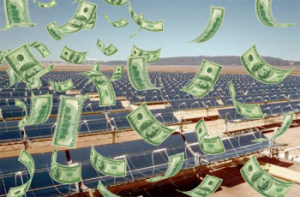Americans have tried for more than a generation to wean ourselves from fossil fuels, and shift to renewable energy. Since the 1990s we have provided tens of billions in major tax subsidies for wind power. By 2005 we were spending enormous resources to develop hydrogen cars. Under President Obama, we have “invested” more than $200 billion in solar energy grants, loan guarantees, tax credits and research.
 Despite these massive investments, Americans still rely almost entirely on traditional fuels for our energy (91 percent from oil, gas, coal, and nuclear). We still get barely 2 percent of America’s energy from wind and solar.
Despite these massive investments, Americans still rely almost entirely on traditional fuels for our energy (91 percent from oil, gas, coal, and nuclear). We still get barely 2 percent of America’s energy from wind and solar.
Ronald Reagan often said “if you want less of something, tax it; if you want more of something, subsidize it.” Apparently that does not always work.
We have attempted to change the economics of energy — providing subsidies to help “jump start” renewable industries, and to help renewable energy compete with our abundant fossil fuels. We have also tried to improve markets for renewable energy by requiring utilities to purchase it. More than half of all states, including Colorado, now have “renewable energy standards” requiring utilities to get a specified percentage of electricity from renewable sources.
Yet after many years of this combination of taxpayer subsidies and tight regulations, something is still not working. Renewables are still not competitive with cheaper fossil fuels, and still provide very little of America’s energy. Why is this approach not working?
I recently heard Todd Myers, director of the Washington Policy Center in Seattle, speak about an entirely new concept, offering a bright future for renewables. Believe it or not, the key might actually be to end the subsidies, and most of the regulations, and to open the floodgate of investment — not from Wall Street venture capitalists, but from everyday consumers.
Myers coined a phrase, “Uber-izing our energy,” to explain the idea of allowing individual Americans to invest in renewable energy through a high-tech “crowdfunding” system. The Uber app allows people to choose the quality and price of their taxi, while increasing supply, profit, and choice. Similarly, smartphone apps and crowdfunding websites could help determine what type of energy reaches the power grid.
The idea came out of those state “renewable energy standards” — but not on purpose. States started requiring utilities to produce higher percentages of electricity from renewables, before there were enough solar or wind generators to comply. So they authorized renewable energy credits (RECs) that could be bought and sold. A utility might plan to build its own renewable facilities, but in the meantime it could buy RECs from other solar or wind generators. The owners of those facilities, in turn, would be able to sell the power they generated, whether the demand was nearby or further away. As planned, that helped create a steadily growing market for more solar and wind generation.
What was not planned might have opened the door to a completely different future for renewable energy. Others, besides utilities, discovered that RECs might be good investments, too — not just because subsidies could make such investments profitable, but also because they provide green choices for conscientious investors who want more renewable energy.
Now, the rapid growth of smart phone apps and “sharing economy” websites have made these choices possible for individuals, too. Now, a consumer in Glenwood Springs could invest in solar energy, not just by putting inefficient solar panels on his mostly-shaded house, but by investing in a more efficient and profitable solar plant in Tucson, by buying a REC. Thus, the Colorado consumer could cause a specific amount of solar power to be added to the grid, and get credit for it against his own electric bill at home.
So, two separate markets developed for the RECs: utilities that need the credits for compliance with government renewable mandates, and investors who want more renewable energy and are willing to buy it. However, there is still a limited amount of solar and wind capacity in America, driving up the price of RECs. Myers argues that if mandates were abolished, the market allowed to function freely, and consumers permitted to buy electric power from whatever source they wished, investment in renewable energy would skyrocket — not because of subsidies or regulations, but because consumers want it.
Some consumers might choose electricity generated from local coal to help their economy. Others would choose solar power from Arizona or wind power from Kansas. We should offer that choice and see how strongly Americans would support renewable energy if given the chance.
(This column originally appeared in the Grand Junction Daily Sentinel April 20, 2016)




Comments on this entry are closed.